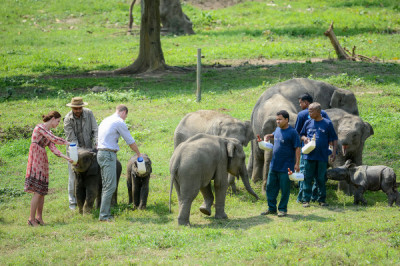Detailed Notes
The CWRC has handled over 5,000 animal cases since its inception, successfully rehabilitating around 60% of them. Species such as rhinos, elephants, tigers, leopards, bears, owls, and cats have found a second chance at life through the centre’s dedicated efforts.
Key Functions and Achievements of CWRC
CWRC plays a crucial role in wildlife rescue operations, especially during annual floods in Kaziranga National Park. The centre runs a Mobile Veterinary Service (MVS) unit equipped with medical supplies to provide emergency aid in remote areas. Its trained veterinarians and field teams respond to distress calls across Assam to ensure timely treatment and rescue.
The centre’s work follows scientific protocols to ensure that animals are fully rehabilitated before release. Orphaned calves of elephants and rhinos are often hand-raised and monitored using radio collars to track their post-release adaptation.
Community Engagement and Education by CWRC
Beyond rescue operations, CWRC engages deeply with local communities, spreading awareness about human-wildlife coexistence and minimizing conflict. By involving locals in conservation efforts, the centre helps build empathy and understanding toward wildlife preservation.
International Recognition to CWRC
In April 2016, The Duke and Duchess of Cambridge (Prince William and Kate Middleton) visited CWRC, highlighting its global significance in wildlife conservation. The centre is also recognized by the Central Zoo Authority (CZA) and supported by the Animal Welfare Division, Government of India.
CWRC Contribution to Assam’s Conservation Landscape
Assam, known for its rich biodiversity and home to the Greater One-Horned Rhinoceros, depends heavily on CWRC’s emergency response system. The centre acts as a backbone for wildlife management during disasters like floods and forest fires. Its strategic location near Kaziranga National Park ensures quick access to the most affected regions.
Research and Scientific Collaboration at CWRC
CWRC integrates veterinary science, ecology, and technology in its conservation model. It conducts long-term studies to improve animal survival rates and contributes to research on wildlife diseases, animal behavior, and habitat restoration.
In essence, the Centre for Wildlife Rehabilitation and Conservation (CWRC) is not merely a rescue facility but a symbol of hope and resilience for Assam’s wildlife, combining science, compassion, and community collaboration.
Quick Info Table on CWRC
| Topic | Details |
|---|---|
| Full Name | Centre for Wildlife Rehabilitation and Conservation (CWRC) |
| Location | Borjuri village, near Panbari Reserve Forest, Kaziranga, Assam |
| Established | 2002 |
| Managed By | Wildlife Trust of India (WTI), Assam Forest Department, and IFAW |
| Recognized By | Central Zoo Authority (CZA), Govt. of India |
| Specialty | India’s only multi-species wildlife rescue and rehabilitation centre |
| Key Services | Wildlife rescue, medical treatment, rehabilitation, release, community outreach |
| Mobile Unit | Mobile Veterinary Service (MVS) |
| Famous Visitors | Duke and Duchess of Cambridge (Prince William & Kate Middleton) |
| Approx. Animals Rescued | 5,000+ |
| Release Success Rate | Around 60% |
| Nearby Attraction | Kaziranga National Park (UNESCO World Heritage Site) |
FAQs with Short Answers
-
What is CWRC?CWRC stands for the Centre for Wildlife Rehabilitation and Conservation, a rescue and rehab centre for wild animals in Assam.
-
Where is CWRC located?It is located in Borjuri village near the Panbari Reserve Forest, close to Kaziranga National Park in Assam.
-
When was CWRC established?CWRC was founded in 2002.
-
Who manages CWRC?It is jointly managed by the Wildlife Trust of India, Assam Forest Department, and IFAW.
-
What is the main goal of CWRC?To rescue, treat, rehabilitate, and release injured or orphaned wild animals back into their natural habitats.
-
How many animals has CWRC rescued?Since its establishment, CWRC has handled over 5,000 animal cases.
-
What species are rehabilitated at CWRC?Rhinos, elephants, tigers, leopards, bears, owls, and many others.
-
Does CWRC have a mobile unit?Yes, the Mobile Veterinary Service (MVS) provides on-site emergency medical care.
-
How does CWRC help during floods?The team conducts wildlife rescue operations during Kaziranga floods, saving stranded animals.
-
Is CWRC recognized by the government?Yes, it is recognized by the Central Zoo Authority and supported by the Government of India.
-
Do orphaned animals get released into the wild?Yes, once they are fit and independent, they are released back to their habitat.
-
Who visited CWRC in 2016?The Duke and Duchess of Cambridge, Prince William and Kate Middleton, visited in April 2016.
-
How does CWRC engage with local communities?Through awareness programs and conservation training to reduce human-wildlife conflict.
-
What is the success rate of animal release?Approximately 60% of rescued animals are successfully released.
-
Why is CWRC important for Assam?It strengthens Assam’s wildlife conservation network and safeguards biodiversity.
